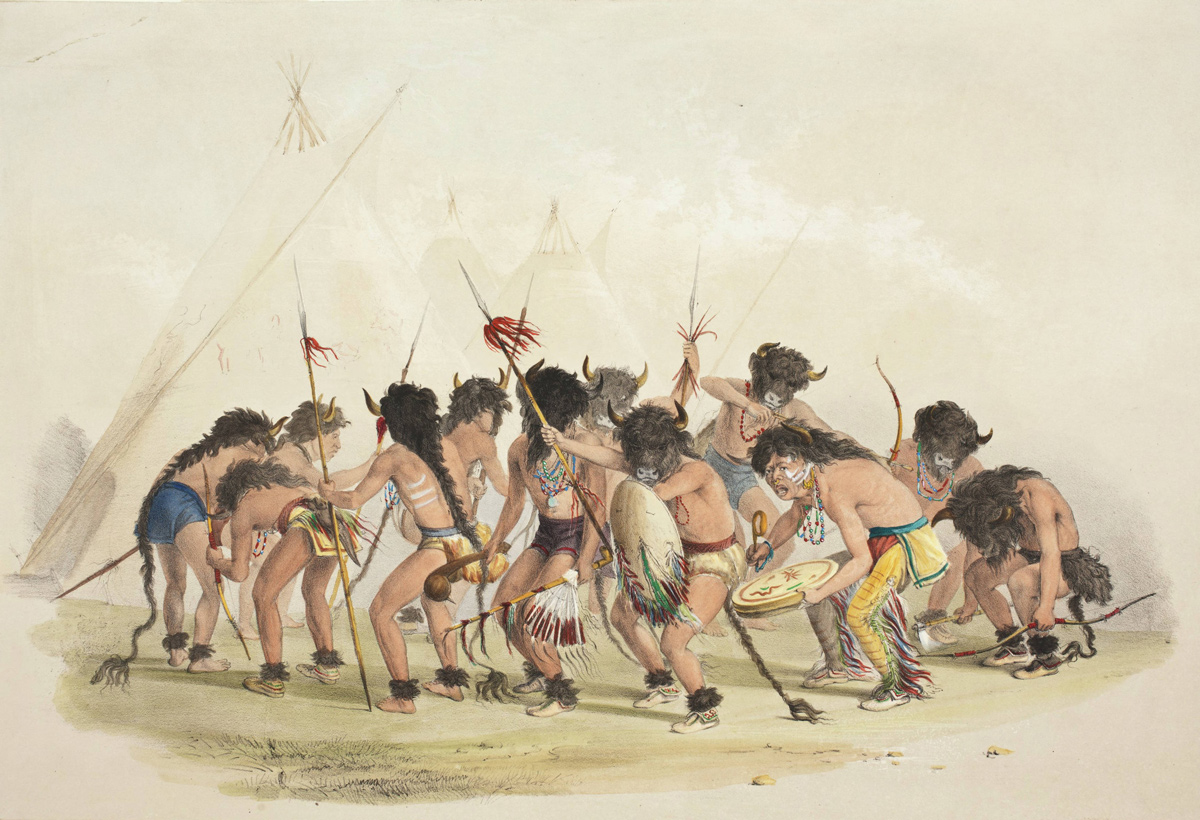Fort Mandan, ND With information gathered from traders and Indians, Clark works on his map of the west. He also describes the Mandan’s Buffalo Dance ceremony.
The Buffalo Dance[1]Originally aired weekdays by Yellowstone Public Radio during the Bicentennial observance of 2003-2006. Narrated by Hal Hansen. Scripts by Whit Hansen and Ed Jacobson. Produced by Leni Holliman. © … Continue reading
Buffalo Dance (Plate 56)
George Catlin (1796–1872)
Courtesy CARLI Digital Collections, Edward E. Ayer Digital Collection (Newberry Library), https://collections.carli.illinois.edu/digital/collection/nby_eeayer/id/58234/rec/6.
Clark’s Buffalo Dance
a Buffalow Dance (or Medison) for 3 nights passed in the 1st Village, a curious Custom . . . . the old men arrange themselves in a circle & after Smoke a pipe . . . . the young men who have their wives back of the circle go to one of the old men with a whining tone and [NB?: request] the old man to take his wife
(we Sent a man to this Medisan last night, they gave him 4 Girls)
all this is to cause the buffalow to Come near So that They may kill thim
—William Clark
Catlin’s Buffalo Dance
Every man in the Mandan village (as I have before said) is obliged by a village regulation, to keep the mask of the buffalo, hanging on a post at the head of his bed, which he can use on his head whenever he is called upon by the chiefs, to dance for the coming of buffaloes. The mask is put over the head, and generally has a strip of the skin hanging to it, of the whole length of the animal, with the tail attached to it, which, passing down over the back of the dancer, is dragging on the ground (PLATE 56). When one becomes fatigued of the exercise, he signifies it by bending quite forward, and sinking his body towards the ground; when another draws a bow upon him and hits him with a blunt arrow, and be falls like a buffalo—is seized by the bye-standers, who drag him out of the ring by the heels, brandishing their knives about him; and having gone through the motions of skinning and cutting him up, they let him off, and his place is at once supplied by another, who dances into the ring with his mask on; and by this taking of places, the scene is easily kept up night and day, until the desired effect has been produced, that of “making buffalo come.”
These dances have sometimes been continued in this village two and three weeks without stopping an instant, until this joyful moment when buffaloes made their appearance. So they never fail; and they think they have been the means of bringing them in.
—George Catlin[2]George Catlin, Letters and Notes on the Manners, Customs, and Condition of the North American Indians (London: Tosswill and Myer, 1841) 1:128.
Clark’s Map
a cold day Some Snow . . . . I imploy my Self drawing a Connection of the Countrey from what information I have recved—
—William Clark
Weather Diary
Ther. at rise
Weather Wind at rise
Thert. at 4 P.M. Weather Wind at 4 P.M. River 20 below [0] cloudy N. W. 18 below [0] snow N. E. raise 2 in. —Meriwether Lewis[3]To assist the reader, the editor of this web page has omitted the date column, merged the “River” columns, and spelled out some abbreviations.
Fort Mandan is a High Potential Historic Site along the Lewis and Clark National Historic Trail managed by the U.S. National Park Service. The North Dakota Department of Parks and Recreation manages a modern reconstruction and the Lewis and Clark Interpretive Center located at US Hwy 83 and ND Hwy 200A.
Knife River Indian Villages National Historic Site is a High Potential Historic Site along the Lewis and Clark National Historic Trail managed by the U.S. National Park Service. A unit of the National Park System, the site is located at 564 County Road 37, one-half mile north of Stanton, North Dakota. It has exhibits, trails, and a visitor center.
Notes
| ↑1 | Originally aired weekdays by Yellowstone Public Radio during the Bicentennial observance of 2003-2006. Narrated by Hal Hansen. Scripts by Whit Hansen and Ed Jacobson. Produced by Leni Holliman. © 2003 by Yellowstone Public Radio. |
|---|---|
| ↑2 | George Catlin, Letters and Notes on the Manners, Customs, and Condition of the North American Indians (London: Tosswill and Myer, 1841) 1:128. |
| ↑3 | To assist the reader, the editor of this web page has omitted the date column, merged the “River” columns, and spelled out some abbreviations. |



